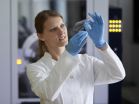Can personal devices interfere with hospital care?
Concordia University study examines whether wireless transmitters represent a danger to patients
2015-06-16
(Press-News.org) This news release is available in French.
Montreal, June 16, 2015 -- Thousands of patients die each year in hospitals across North America due to medical errors that could be prevented were doctors and nurses provided with instant access to patient records via wireless technology. Cue the catch-22: the electromagnetic radiation caused by those very devices can interfere with electronic medical equipment and thus lead to serious clinical consequences for patients.
Luckily, that could soon change thanks to new research from Concordia University that helps define a clear rule of thumb for how close health-care workers with their Wi-Fi devices can be to electronic medical equipment.
In a study published recently in IEEE Transactions on Electromagnetic Compatibility, researchers from the Faculty of Engineering and Computer Science assessed the risk that a medical device will malfunction when radio waves that emanate from portable devices like tablet computers are present in a hospital room.
Bedside matters
Hospitals often specify that staff members carrying wireless transmitters not approach sensitive electronic medical devices any closer than a designated minimum separation distance (MSD).
"We wanted to see whether this policy really affects the risk of electromagnetic interference," says the study's lead author Mehdi Ardavan, who recently completed his PhD in Electrical Engineering. "But there were two main obstacles: one was the high cost of determining and computing the electromagnetic field strength; the second was the lack of any study on how the medical staff carrying the wireless devices move around a patient's bed."
So Ardavan and his colleagues combined existing methods to develop a tool to estimate the likelihood that a particular field would affect a given medical device. The researchers combined this method with a new mathematical model to account for the roaming nature of the transmitters, given that hospital staff are almost always on their feet.
"We found that MSD policy really does work. If hospital staff comply fully with the policy, they can have a tablet in the same room as the patient and medical equipment without posing a danger," says Ardavan.
It's only when hospital staff become lax with the rules that issues occur. "We observed that the risk reduces rapidly by increasing the MSD from zero to a small value. After that, the risk doesn't decrease when you increase the MSD beyond a level that we call the optimal MSD. This indicates that specifying larger minimum separation distances doesn't necessarily increase safety."
For Christopher Trueman, senior author and professor in the Department of Electrical and Computer Engineering, the message is clear. "Hospitals need to be vigilant that staff members obey the MSD rule. The nature of the problem is that there can never be zero risk, but by complying with MSD, the risk can be reduced to a low enough value that it's very unlikely there will be interference."
The bottom line: keep your wireless device further than arm's length from medical equipment and the risk of interference is very small.
INFORMATION:
Related links:
Faculty of Engineering and Computer Science
Department of Electrical and Computer Engineering
IEEE
Media contact:
Cléa Desjardins
Senior advisor, media relations
University Communications Services
Concordia University
Phone: 514-848-2424, ext. 5068
Email: clea.desjardins@concordia.ca
Web: http://www.concordia.ca/now/media-relations
Twitter: @CleaDesjardins
ELSE PRESS RELEASES FROM THIS DATE:
2015-06-16
Humans aren't the only ones who like to cruise along the waterways, so do viruses. For the first time, a map of fecal viruses traveling our global waterways has been created using modeling methods to aid in assessing water quality worldwide.
"Many countries are at risk of serious public health hazards due to lack of basic sanitation," said Joan Rose, Homer Nowlin Chair in water research at Michigan State University. "With this map, however, we can assess where viruses are being discharged from untreated sewage and address how disease is being spread. With that, we can ...
2015-06-16
Tropical Storm Bill was making landfall at 11 a.m. CDT on Matagorda Island, Texas on June 16 as NASA and NOAA satellites gathered data on the storm. At NASA a movie of Bill's landfall was created using data from NOAA's GOES-East satellite. The center of Bill is expected to move inland over south-central Texas during the afternoon and night of June 16.
On June 15 at 19:15 UTC (3:15 p.m. EDT) the MODIS instrument aboard NASA's Aqua satellite captured a visible image of Tropical Storm Bill approaching Texas and Louisiana. Powerful thunderstorms circled the center in fragmented ...
2015-06-16
Results from a new study led the Georgia Institute of Technology's School of Psychology and University of Minnesota's Carlson School of Management show that, compared to younger job seekers, older adults receive fewer job offers, search for weeks longer and are ultimately less likely to find re-employment after losing a job. The study is published by the journal Psychological Bulletin.
"There's very robust evidence that as an individual moves beyond age 50, they experience a large penalty toward how quickly they will find a job," says Professor Connie Wanberg, the Industrial ...
2015-06-16
CLEMSON, S.C. - Drowsy drivers take a heavy toll on the nation's highways. So finding a reliable way to test for fatigue to mitigate its potential damage could have a significant impact on highway safety.
U.S. statistics reveal drowsy drivers are five times more likely to be involved in an accident, or a near-crash incident, than alert drivers. Furthermore, drowsy or fatigued drivers are responsible for an estimated 56,000 crashes annually with more than 40,000 of them resulting in fatal and non-fatal injuries. Closer to home, there are more than 730 traffic accidents ...
2015-06-16
SEATTLE -- The world invested more than $200 billion to improve health in lower-income countries over the past 15 years.
Global health financing increased significantly after 2000, when the United Nations established the Millennium Development Goals, which included a strong focus on health. This trend in funding has only recently started to change, according to new research by the Institute for Health Metrics and Evaluation (IHME) at the University of Washington. The article, "Sources and Focus of Health Development Assistance, 1990-2014," was published online June 16 ...
2015-06-16
New York - An immensely powerful yet invisible force pulls water from the earth to the top of the tallest redwood and delivers snow to the tops of the Himalayas. Yet despite the power of evaporating water, its potential to propel self-sufficient devices or produce electricity has remained largely untapped -- until now.
In the June 16 online issue of Nature Communications, Columbia University scientists report the development of two novel devices that derive power directly from evaporation - a floating, piston-driven engine that generates electricity causing a light to ...
2015-06-16
The urban mosquito that carries the dengue fever virus is hitching rides on river boats connecting the Amazonian town of Iquitos, Peru, with rural areas.
PLOS Neglected Tropical Diseases published a study by disease ecologists at Emory University, showing how the Aedes aegypti mosquito, which is normally associated with urban areas, is tapping human transportation networks to expand its range.
"The majority of large barges we surveyed were heavily infested," says Sarah Anne Guagliardo, who led the study as a PhD student in the lab of Uriel Kitron, chair of Emory's Department ...
2015-06-16
Plants are a ubiquitous and essential part of our lives. Estimates suggest there are hundreds of thousands of plant species known to science. How many species are there, really? How are they related? How many are threatened with extinction? Answering these questions in such an enormous clade of life is an important but daunting task for scientists.
Modern molecular techniques and, in particular, next-generation sequencing provide a powerful tool set to begin uncovering these answers. DNA regions can quickly be obtained and compared across species to infer relationships ...
2015-06-16
This news release is available in German.
They are thin, light-weight, flexible and can be produced cost- and energy-efficiently: printed microelectronic components made of synthetics. Flexible displays and touch screens, glowing films, RFID tags and solar cells represent a future market. In the context of an international cooperation project, physicists at the Technische Universität München (TUM) have now observed the creation of razor thin polymer electrodes during the printing process and successfully improved the electrical properties of the printed ...
2015-06-16
This news release is available in French. A multidisciplinary group of researchers from British Columbia has developed a participatory action research program to help address healthy body weight in children.
The SCOPE (Sustainable Childhood Obesity Prevention through Community Engagement) program has a simple message and was developed to engage communities to take action to prevent childhood obesity. The first phase of the SCOPE program was funded by Child Health BC, an initiative of BC Children's Hospital, and was carried out in communities in British Columbia. The ...
LAST 30 PRESS RELEASES:
[Press-News.org] Can personal devices interfere with hospital care?
Concordia University study examines whether wireless transmitters represent a danger to patients



